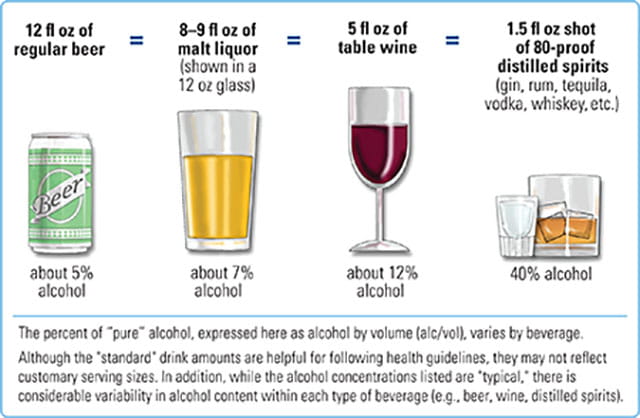Recommended Alcohol Guidelines - Moderate (Social) Drinking Plan
Recommended alcohol guidelines can help you in a few ways:
1. Understand what is considered healthy alcohol use.
2. Decide if you have an alcohol problem.
What is Moderate Alcohol Use?
Guidelines for moderate drinking have been set by the US Department of Health and Human Services and the World Health Organization.
- The US guidelines suggest no more than 1 drink per day for women and no more than 2 drinks per day for men. A drink is defined as 12 oz of beer, 5 oz of wine, or 1.5 oz of spirits.
- The WHO guidelines suggest no more than 2 drinks per day, and no more than 5 drinking days per week. They recommend 2 non-drinking days. Of course, you can't stockpile your drinks, and have them all at the end of the week.
A Standard Drink - The Definition of a Drink
A standard drink is 14g of pure alcohol according to the US Department of Health and Human Services. The World Health Organization defines a drink as 10g of pure alcohol.
Each milliliter of pure alcohol weighs 0.79 grams. Therefore, you can calculate the alcohol content of a drink with the following formula:
- 1 can of beer (330 ml, 12 oz) at 5% (strength) x 0.79 (conversion factor) = 13 grams of alcohol
- 1 glass of wine (140 ml, 5 oz) at 12% x 0.79 = 13.3 grams of alcohol
- 1 shot of liquor (40 ml, 1.5 oz) at 40% x 0.79 = 12.6 grams of alcohol
Note that a 750ml bottle of wine contains 5 drinks. Therefore 2 drinks a day is less than half a bottle of wine a day.

Moderate (Social) Drinking Plan
If you don’t have an alcohol problem, you should be able to easily follow a moderate drinking plan. This is a moderate drinking plan to help you decide.
Keep an honest journal of how much you drink every day for 6 months, and see if you can stick to moderate drinking. It's important that you do this for at least 6 months, because it's easy to control your drinking for a short period of time.
If there are days when you drink more than a moderate amount, make note of the circumstances and identify your triggers. If you're happy with your use – great. But if you're not happy, or if you can't stick to moderate drinking, then that should tell you something.
Ultimately, people who are addicted to alcohol decide to quit drinking, because they realize it's easier to not drink, than it is to control their drinking.
- Set a realistic goal for your alcohol use. Decide ahead of time how much and how often you would like to drink.
- Keep an honest journal of your drinking. This helps you become mindful of your drinking.
- Start with a non-alcoholic drink to quench your thirst. When you’re at a social event make sure you have a non-alcoholic drink to start. Thirst can make you drink more alcohol than you need. This also helps you become more mindful of your drinking.
- Don’t drink on an empty stomach. Make eating part of the experience. Hunger can also make you drink more alcohol than you need.
- Alternate alcoholic and non-alcoholic drinks. Don't have all your alcoholic drinks at once, or you may be tempted to drink more than you planned. Instead have at least one glass of water before each alcoholic drink.
- Avoid heavy drinking situations. Some situations are associated with heavy drinking, and it may be difficult to stick to your plan. Learn to recognize and avoid heavy drinking situations.
More Mental Health Information …
The book “I Want to Change My Life.” contains more information on how to overcome anxiety, depression, and addiction.
